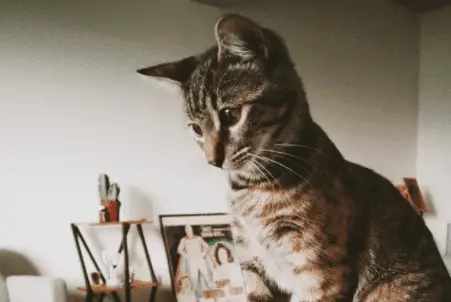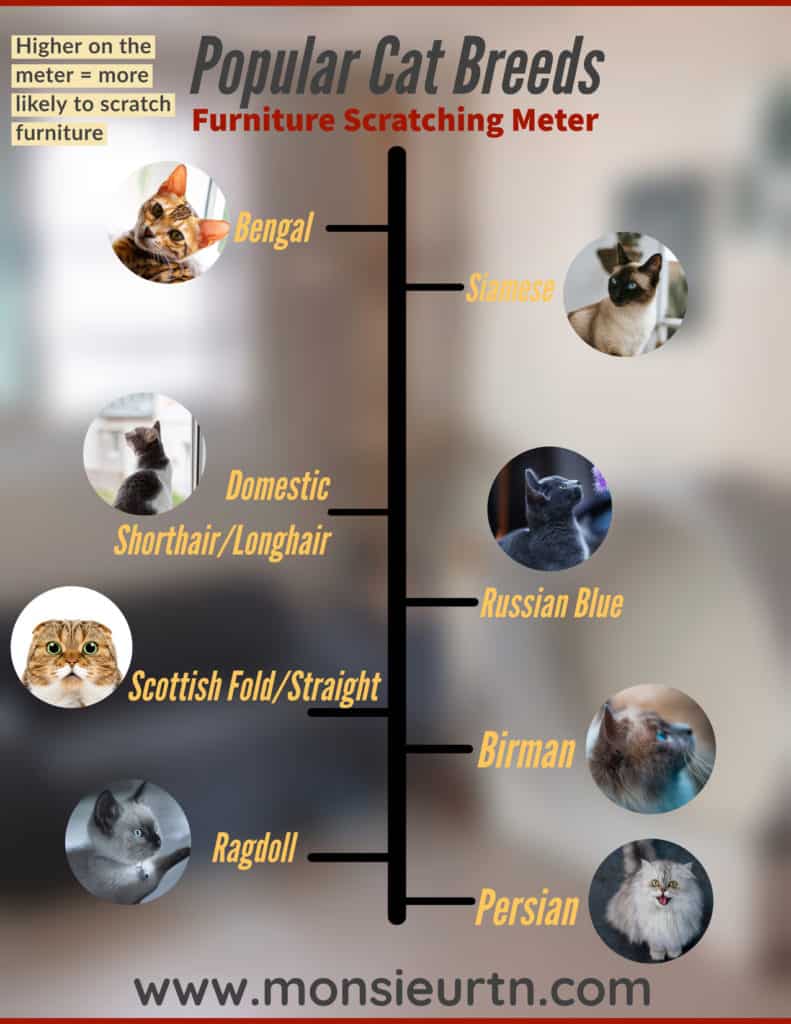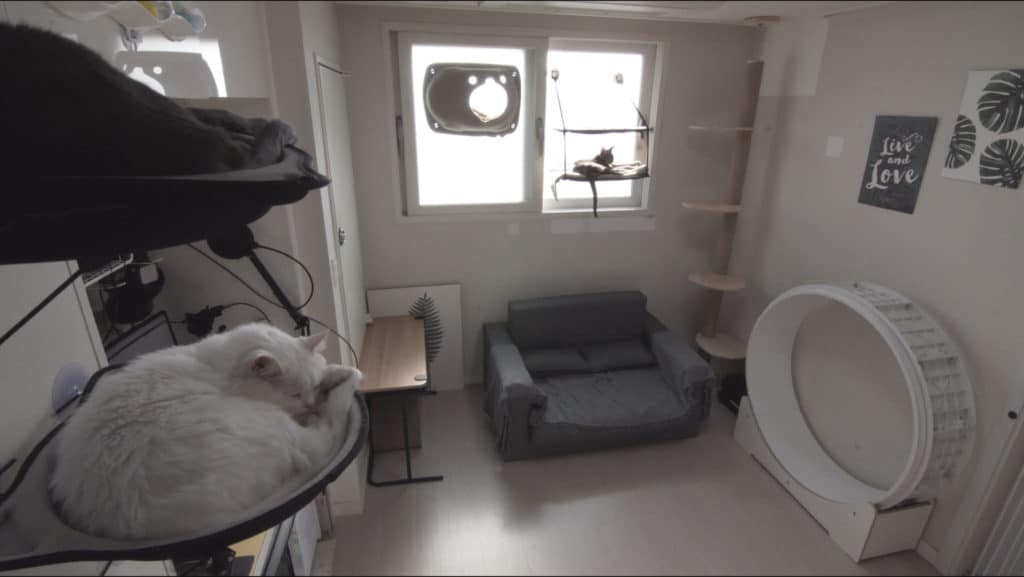If you’re looking for a cat that will thrive in a smaller space, then it’s important to know which breeds will be the best fit for your life. The breed of cat you choose will depend on many factors, including its activity level, adaptability to a small home, and personality.
When choosing the best apartment cat breed, you should consider your lifestyle and personality as well. For example, you should avoid highly active cats if you don’t have much time to devote to playing with them and keeping them stimulated. You should also avoid shy or skittish cats if you have a small living space; they’ll feel even more confined if they’re uncomfortable.

As for personality, some breeds are more likely to be clingy or vocal than others. If you’re a quiet person who doesn’t like a lot of attention or drama (maybe from your neighbors), then you should avoid breeds that are known for being needy or demanding.
Which Popular Cats Are the Best Fit To Live in an Apartment?
In 2020, the Cat Fancier’s Association (a well-known non-profit organization of the world’s largest registry of pedigreed cats) tallied up its statistics to determine the most popular cat breeds. It’s no surprise that all of these cats are great indoor and apartment cats, as most of the popular cat breeds (seeing as they’re quite expensive) are bred to be indoor friendly, healthy, and well-adapted cats.
According to the Cat Fancier’s Association, the 10 most popular cat breeds that are also great for apartments are:
- Ragdoll
- Exotic Shorthair
- Maine Coon
- Persian
- British Shorthair
- Devon Rex
- Abyssinian
- American Shorthair
- Scottish Fold
- Sphynx
For the full list of cat breeds and how they are in apartments and indoor types of environments – see below!
Apartment Cat Resource
This page will serve as a glance resource for most of the popular cat breeds out there and see if the breed fits you as a cat owner in an apartment-type environment. These are the specific categories to be aware of when living in an apartment:
- Energy levels – How active they are throughout the day. It can be a good fit for people that have the time to interact with their cat. However, for those that are away from work, it’s best to choose a more relaxed cat breed for apartment living.
- Vocalizations (how quiet or loud they can be) – This can be quite important depending on the size of your apartment and how well it is soundproofed. Some cats are intensely vocal and as such, they can affect you or your neighbors. There are ways to manage their vocalizations and minimize incessant meowing, click here!
- Recommended cat configurations – If they should be with other cat companions or flexible enough to live alone as a solo-cat. Most cats with higher energy will benefit a lot from having a companion and will help them keep them out of trouble in an apartment living area.
As a reminder, although some cats might be rated low – it doesn’t mean that it’s impossible to raise them in an apartment (take my Bengal, for example, I raised him exclusively in an apartment). It means how difficult it might be for an owner to prepare the right environment to become healthy and happy cats without behavioral issues.

This chart is to be used as a reference to quickly get an overview of the specific breed that is good in an apartment. There is no hard and fast rule as cats are all individuals depending on how they were raised and their environment.
| Breed | Energy | Vocalization | Configuration: Solo, Multi, Flexible | Apartment Cat Adaptability Rating (1-10) |
|---|---|---|---|---|
| Domestic Long/Short Hair | Medium | Variable | Flexible | 7 – makes up 95% of the mainstream cat population in the United States. Each one is special in its own way. |
| Ragdoll** | Low | Quiet | Flexible | 10 – mellow disposition and unique look. Ragdoll Cats are the most popular for a reason. |
| Persian** | Low | Quiet | Flexible | 9 – known for their luxurious coats and easy-going temperaments. |
| Exotic Shorthair** | Low | Quiet | Flexible | 9 – the lazy person’s Persian. Less hair management – more fun! |
| Maine Coon Cat** | Medium | Vocal | Multi | 7 – gentle giants that can fit the lifestyle of any individual. However, because of their potentially large size – they may need a larger apartment. |
| British Shorthair** | Low to Medium | Quiet | Flexible | 8 – very loving and very chunky. They’re the cat you want to hang out with on a chilly day. |
| Siamese | Medium to High | Very Vocal | Multi | 5 – vocal, intelligent, and sometimes very persistent. |
| Abyssinian** | Low to Medium | Quiet | Flexible | 8 – almost Egyptian-looking cats. They’re known for being small, intelligent, and agile cats. |
| American Shorthair** | Low to Medium | Quiet | Flexible | 10 – playful and round. A balanced cat for all types of homes and families. |
| Scottish Fold/Straight** | Low | Quiet | Flexible | 10 – supremely popular all around the world. Their folded ears and round eyes make them one of the most sought-after indoor cats. |
| Sphynx** | Medium | Very Vocal | Flexible | 7 – no hair, no more worrying about shedding! These out-going and energetic cats can be a little bit high maintenance in apartments. |
| Bengal | High | Very Vocal | Multi | 3 – beware of the Bengal if you’re not prepared in an apartment. They’re loved for their unique appearance but not recommended for the first-time cat owner. |
| Burmese | Low to Medium | Quiet | Flexible | 9 – a small and active cat breed that is perfect for the indoors and apartments. They’re very social and loving cats. |
| Balinese | Medium | Moderately Vocal | Multi | 6 – similar to the Siamese cat but a little bit milder. |
| Cornish Rex | Low to Medium | Quiet | Flexible | 9 – sort of alien-looking cats. They’re affectionate and social cats. |
| Chartreux | Low | Quiet | Flexible | 9 – these cats are content living indoors, and in France, they’re mainly apartment cats. |
| Himalayan | Low | Quiet | Flexible | 8 – these cats have little desire to explore the outdoors. They’re content just watching the world outside. |
| Korat | Medium | Moderately Vocal | Flexible | 7 – these cats can adapt well to an indoor environment. They’re affectionate and known as a “good luck cat” for many homes in Thailand. |
| LaPerm | Medium | Quiet | Flexible | 8 – their quiet, easygoing demeanor and their contentment indoors make them great apartment cats. |
| Manx | Medium | Quiet | Flexible | 7 – nothing, in particular, stands out about the Manx in terms of personality – however, this makes them quite adaptable to living indoors. |
| Munchkin | Low to Medium | Quiet | Flexible | 9 – because of their short legs and stubby nature, they’re definitely a breed that should be kept indoors. |
| Nebelung | Low to Medium | Quiet | Flexible | 8 – smart, intelligent cats that adapt well towards apartment living. |
| Norwegian Forest | Low to Medium | Quiet | Flexible | 8 – a natural breed of domestic cat in Northern Europe. They’re friendly and generally good with people. |
| Savannah | High | Very Vocal | Multi | 2 – much-like Bengal cats, they’re high-energy cats that are not only smart but persistent. |
| Devon Rex** | Low to Medium | Quiet | Flexible | 9 – popular for their unique wavy coats and expressive personality. |
| Siberian | Low to Medium | Moderately Quiet | Flexible | 8 – These are sometimes demanding attention, but they love just lounging around with their humans. |
| Singapura | Medium | Moderately Quiet | Flexible | 8 – a small cat breed that fits into any living space. They’re curious and playful and make great apartment companions. |
| Tonkinese | Medium | Moderately Vocal | Multi | 6 – they’re lively, playful, and quite talkative. They can make good apartment cats as they’re a lot milder than their Siamese cousins. |
| Toyger | High | Very Vocal | Multi | 3 – the Bengal cat’s cousin, again very high energy and vocal cats. |
| Turkish Angora | Low to Medium | Quiet | Flexible | 8 – calm cats that are content to be at home. They’re affectionate and loving towards humans and other animals. |
| Bombay | Low to Medium | Quiet | Flexible | 8 – a very social cat that likes to be around its humans and guests. |
| Russian Blue | Low to Medium | Quiet | Flexible | 9 – muscular cats that do well with humans and other animals. They’re rarely destructive and love cuddles. |
Cat Breeds to Avoid in an Apartment
Some cats are sometimes too much to handle in apartments without properly cat-proofing them first. A few more active breeds will likely be less bored and better-mannered if they have a little more space to roam around and explore.
These cat breeds are the ones to avoid in a small apartment:
- Bengal
- Savannah
- Toyger
- Siamese
Again, it’s no surprise that they got the lowest score in their apartment ratings. The higher the breed, the more likely it might develop negative behavior habits later on, for example, being destructive with items around the house, scratching inappropriate objects, and possibly even developing some aggressive behaviors.

If you’re still interested in having one of these high-energy cat breeds, learn about them as much as you can. Start to think about how they can use the apartment to satisfy their cat instincts is important in raising well-balanced cats.
Tips for Keeping Any Cat Breed Happy, Safe, and Healthy in Apartments
Before you continue, are you a first-time cat owner who is about to adopt a cat in an apartment? See my complete apartment cat guide!

Keeping a cat engaged, happy, and stimulated in an apartment isn’t difficult, expensive, or time-consuming. However, it might take a bit of creative thinking about how a cat might use and navigate the space.
Here are the main tips and hacks for anybody living in an apartment with cats (each will take you to all of their respective detailed guides!):
- Catification in a way that’s simple, easy, and inexpensive.
- Don’t allow your cat to free-feed.
- Have a proper play regimen for your cats.
- Know the proper weight-management strategies for indoor/apartment cats.
- Cat hair and shedding management are all about prevention.
Those living in studio apartments with their cats (or other super small living spaces) might be worried that your space might be too small for any cats – it’s entirely possible to raise well-balanced cats in these types of environments well.
- How to Live With 3 Cats in a Studio Apartment
- How Much Does It -Really- Cost to Live With Cats in a Studio Apartment?
- Things I’ve Learned Living With 4 Cats in a Studio Apartment!
- How to Control Cat Odor in a Studio Apartment
- How to Play With Your Cat in a Studio Apartment
- How Large Should Your Apartment Be?
